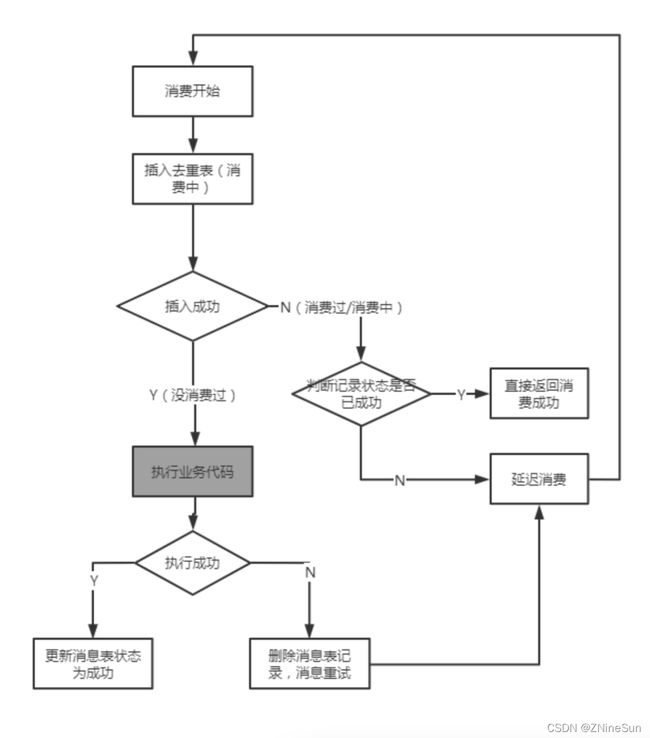rabbitmq实现幂等性操作
文章目录
- 1.场景描述
-
- 1.1 场景1
- 1.2 场景2
- 2.原理
- 3.实战开发
-
- 3.1 建表
- 3.2 集成mybatis-plus
- 3.3 集成RabbitMq
-
- 3.3.1 安装mq
- 3.3.2 springBoot集成mq
- 3.4 具体实现
-
- 3.4.1 mq配置类
- 3.4.2 生产者
- 3.4.3 消费者
1.场景描述
消息中间件是分布式系统常用的组件,无论是异步化、解耦、削峰等都有广泛的应用价值。我们通常会认为,消息中间件是一个可靠的组件——这里所谓的可靠是指,只要我把消息成功投递到了消息中间件,消息就不会丢失,即消息肯定会至少保证消息能被消费者成功消费一次,这是消息中间件最基本的特性之一,也就是我们常说的“AT LEAST ONCE”,即消息至少会被“成功消费一遍”。
1.1 场景1
什么意思呢?举个例子:一个消息M发送到了消息中间件,消息投递到了消费程序A,A接受到了消息,然后进行消费,但在消费到一半的时候程序重启了,这时候这个消息并没有标记为消费成功,这个消息还会继续投递给这个消费者,直到其消费成功了,消息中间件才会停止投递。
这种情景就会出现消息可能被多次地投递。
1.2 场景2
还有一种场景是程序A接受到这个消息M并完成消费逻辑之后,正想通知消息中间件“我已经消费成功了”的时候,程序就重启了,那么对于消息中间件来说,这个消息并没有成功消费过,所以他还会继续投递。这时候对于应用程序A来说,看起来就是这个消息明明消费成功了,但是消息中间件还在重复投递。
以上两个场景对于消息队列来说就是同一个messageId的消息重复投递下来了。
2.原理
全局唯一ID + (Redis/数据库)
原理很简单,我们先看个流程图:

我们利用消息id来判断消息是否已经消费过,如果该信息被消费过,那么消息表中已经 会有一条数据,由于消费时会先执行插入操作,此时会因为主键冲突无法重复插入,我们就利用这个原理来进行幂等的控制。
更详细的原理说明和解释可以看一下《MQ幂等、去重的解决方案》
本文对于原理不在过多赘述,主要是看看怎么在项目中实现的
3.实战开发
3.1 建表
DROP TABLE IF EXISTS `message_idempotent`;
CREATE TABLE `message_idempotent` (
`message_id` varchar(50) NOT NULL COMMENT '消息ID',
`message_content` varchar(2000) DEFAULT NULL COMMENT '消息内容',
`status` int DEFAULT '0' COMMENT '消费状态(0-未消费成功;1-消费成功)',
`retry_times` int DEFAULT '0' COMMENT '重试次数',
PRIMARY KEY (`message_id`)
) ENGINE=InnoDB DEFAULT CHARSET=utf8;
3.2 集成mybatis-plus
《springBoot集成mybatisPlus》
3.3 集成RabbitMq
3.3.1 安装mq
推荐使用docker安装rabbitmq,还未安装的可以参考以下信息:
- windows下的安装
- ubuntu下的安装
- docker安装
3.3.2 springBoot集成mq
- 1.添加依赖
<dependency>
<groupId>org.springframework.bootgroupId>
<artifactId>spring-boot-starter-amqpartifactId>
dependency>
- 2.修改application.properties
# 配置rabbbitMq
spring.rabbitmq.host=192.168.1.2
spring.rabbitmq.port=5672
spring.rabbitmq.username=ninesun
spring.rabbitmq.password=zx12345678
#开启重试监听,设置重试5次,间隔3s
# 需要开启手动确认机制,要不然代码中手动确认会无效的
spring.rabbitmq.listener.simple.acknowledge-mode=manual
spring.rabbitmq.listener.simple.retry.enabled=true
spring.rabbitmq.listener.simple.retry.max-attempts=5
spring.rabbitmq.listener.simple.retry.max-interval=3000ms
3.4 具体实现
3.4.1 mq配置类
- DirectRabbitConfig
import org.springframework.amqp.core.Binding;
import org.springframework.amqp.core.BindingBuilder;
import org.springframework.amqp.core.DirectExchange;
import org.springframework.amqp.core.Queue;
import org.springframework.context.annotation.Bean;
import org.springframework.context.annotation.Configuration;
@Configuration
public class DirectRabbitConfig {
/**
* 消息队列,消息通过发送和路由之后最终到达的地方,到达 Queue的消息即进入逻辑上等待消费的状态。每个消息都会被发送到一个或多个队列。
*/
public static final String QUEUE_NAME = "directQueue";//队列名称
/**
* 消息交换机,是消息第一个到达的地方。消息通过它指定的路由规则,分发到不同的消息队列中去。
*/
public static final String EXCHANGE_NAME = "directExchange";
/**
* 路由关键字,Exchange根据这个关键字进行消息投递。
*/
public static final String ROUTING_KEY = "directRouting";
// 创建一个队列名称为directQueue
@Bean
public Queue directQueue() {
/**
* 在new Queue()的时候是有3个构造方法的,由于参数的不同,创建的结果也不一样,下面说下里面的参数
*durable:是否持久化,默认是false,持久化队列:会被存储在磁盘上,当消息代理重启时仍然存在,暂存队列:当前连接有效
*exclusive:默认也是false,只能被当前创建的连接使用,而且当连接关闭后队列即被删除。此参考优先级高于durable
*autoDelete:是否自动删除,当没有生产者或者消费者使用此队列,该队列会自动删除。
* 一般设置一下队列的持久化就好,其余两个就是默认false
*/
return new Queue(QUEUE_NAME, true);
}
// 创建一个Direct交换机起名为TestDirectExchange
@Bean
public DirectExchange directExchange() {
return new DirectExchange(EXCHANGE_NAME, true, false);
}
// 将队列和交换机绑定, 并设置用于匹配键:directRouting
@Bean
public Binding bindingDirect() {
return BindingBuilder.bind(directQueue()).to(directExchange()).with(ROUTING_KEY);
}
}
- 死信队列配置
由于rabbitMq中不直接支持死信队列,需要我们利用插件rabbitmq_delayed_messgae_exchage进行开启
具体如何开启可以参考《rabbitMq实现延迟队列-4.4节》
import org.springframework.amqp.core.Binding;
import org.springframework.amqp.core.BindingBuilder;
import org.springframework.amqp.core.CustomExchange;
import org.springframework.amqp.core.Queue;
import org.springframework.beans.factory.annotation.Qualifier;
import org.springframework.context.annotation.Bean;
import org.springframework.context.annotation.Configuration;
import java.util.HashMap;
import java.util.Map;
@Configuration
public class DelayedRabbitMQConfig {
public static final String DELAYED_QUEUE_NAME = "delay.queue.demo.delay.queue";
public static final String DELAYED_EXCHANGE_NAME = "delay.queue.demo.delay.exchange";
public static final String DELAYED_ROUTING_KEY = "delay.queue.demo.delay.routingkey";
@Bean
public Queue immediateQueue() {
return new Queue(DELAYED_QUEUE_NAME);
}
@Bean
public CustomExchange customExchange() {
Map<String, Object> args = new HashMap<>();
args.put("x-delayed-type", "topic");
return new CustomExchange(DELAYED_EXCHANGE_NAME, "x-delayed-message", true, false, args);
}
@Bean
public Binding bindingNotify(@Qualifier("immediateQueue") Queue queue,
@Qualifier("customExchange") CustomExchange customExchange) {
return BindingBuilder.bind(queue).to(customExchange).with(DELAYED_ROUTING_KEY).noargs();
}
}
3.4.2 生产者
- 1.消费订单的生产者
import com.example.mq_repeat_idempotent.mq.config.DirectRabbitConfig;
import com.example.mq_repeat_idempotent.service.IMessageIdempotentService;
import lombok.extern.slf4j.Slf4j;
import org.springframework.amqp.core.AmqpTemplate;
import org.springframework.amqp.core.Message;
import org.springframework.amqp.core.MessageProperties;
import org.springframework.beans.factory.annotation.Autowired;
import org.springframework.stereotype.Component;
import java.util.UUID;
@Component
@Slf4j
public class Sender_Direct {
@Autowired
private AmqpTemplate rabbitTemplate;
@Autowired
IMessageIdempotentService iMessageIdempotentService;
/**
* 用于消费订单
*
* @param orderId
*/
public void send2Direct(String orderId) {
log.info("订单Id:" + orderId);
//创建消费对象,并指定全局唯一ID(这里使用UUID,也可以根据业务规则生成,只要保证全局唯一即可)
MessageProperties messageProperties = new MessageProperties();
messageProperties.setMessageId(UUID.randomUUID().toString());
messageProperties.setContentType("text/plain");
messageProperties.setContentEncoding("utf-8");
Message message = new Message(orderId.getBytes(), messageProperties);
rabbitTemplate.convertAndSend(DirectRabbitConfig.EXCHANGE_NAME, DirectRabbitConfig.ROUTING_KEY, message);
}
}
- 2.死信队列的生产者
import lombok.extern.slf4j.Slf4j;
import org.springframework.amqp.core.Message;
import org.springframework.amqp.core.MessageProperties;
import org.springframework.amqp.rabbit.core.RabbitTemplate;
import org.springframework.beans.factory.annotation.Autowired;
import org.springframework.stereotype.Component;
import org.springframework.stereotype.Service;
import java.util.UUID;
import static com.example.mq_repeat_idempotent.mq.config.DelayedRabbitMQConfig.DELAYED_EXCHANGE_NAME;
import static com.example.mq_repeat_idempotent.mq.config.DelayedRabbitMQConfig.DELAYED_ROUTING_KEY;
@Service
@Slf4j
public class DelaySender {
@Autowired
private RabbitTemplate rabbitTemplate;
public void sendDelayMsg(String msg, Integer delayTime) {
log.info("接受到信息为:" + msg + ",延迟:" + delayTime + "s后发送");
rabbitTemplate.convertAndSend(DELAYED_EXCHANGE_NAME, DELAYED_ROUTING_KEY, msg, a -> {
a.getMessageProperties().setDelay(delayTime * 1000);
return a;
});
}
public void sendDelayMsg(String msg, String messageId, Integer delayTime) {
log.info("接受到信息为:" + msg + ",延迟:" + delayTime + "s后发送");
//创建消费对象,并指定全局唯一ID(这里使用UUID,也可以根据业务规则生成,只要保证全局唯一即可)
MessageProperties messageProperties = new MessageProperties();
messageProperties.setMessageId(messageId);
messageProperties.setContentType("text/plain");
messageProperties.setContentEncoding("utf-8");
Message message = new Message(msg.getBytes(), messageProperties);
rabbitTemplate.convertAndSend(DELAYED_EXCHANGE_NAME, DELAYED_ROUTING_KEY, message, a -> {
a.getMessageProperties().setDelay(delayTime * 1000);
return a;
});
}
}
3.4.3 消费者
import com.baomidou.mybatisplus.core.conditions.update.UpdateWrapper;
import com.example.mq_repeat_idempotent.mq.config.DelayedRabbitMQConfig;
import com.example.mq_repeat_idempotent.mq.config.DirectRabbitConfig;
import com.example.mq_repeat_idempotent.mq.provider.DelaySender;
import com.example.mq_repeat_idempotent.po.MessageIdempotent;
import com.example.mq_repeat_idempotent.service.IMessageIdempotentService;
import com.rabbitmq.client.Channel;
import lombok.extern.slf4j.Slf4j;
import org.springframework.amqp.core.Message;
import org.springframework.amqp.rabbit.annotation.RabbitListener;
import org.springframework.beans.factory.annotation.Autowired;
import org.springframework.stereotype.Component;
import org.springframework.util.StringUtils;
import java.io.IOException;
import java.util.Date;
import static com.example.mq_repeat_idempotent.mq.config.DelayedRabbitMQConfig.DELAYED_QUEUE_NAME;
@Component
@Slf4j
public class Receiver_Direct {
@Autowired
IMessageIdempotentService iMessageIdempotentService;
@Autowired
DelaySender delaySender;
private static final Integer delayTimes = 30;//延时消费时间,单位:秒
@RabbitListener(queues = {DirectRabbitConfig.QUEUE_NAME, DELAYED_QUEUE_NAME})
public void receiveD(Message message, Channel channel) throws IOException {
// 获取消息Id
String messageId = message.getMessageProperties().getMessageId();
if (StringUtils.isEmpty(messageId)) {
// 开启消息确认机制
channel.basicAck(message.getMessageProperties().getDeliveryTag(), false);
return;
}
String msg = new String(message.getBody());//获取消息
Integer orderId = Integer.valueOf(msg);
//向数据库插入数据
MessageIdempotent messageIdempotent = new MessageIdempotent();
messageIdempotent.setMessageId(messageId);
messageIdempotent.setMessageContent(msg);
messageIdempotent.setRetryTimes(0);
boolean save = true;
try {
save = iMessageIdempotentService.save(messageIdempotent);//向消息表中插入数据
} catch (Exception e) {
e.printStackTrace();
save = false;
} finally {
if (!save) {//说明属于重重复请求
//获取消息表的数据来判断是否消费成功
messageIdempotent = iMessageIdempotentService.getById(messageId);
Integer status = messageIdempotent.getStatus();
if (status == 1) {//说明已经消费成功,无需重复消费
channel.basicAck(message.getMessageProperties().getDeliveryTag(), false);//手动确认消费成功
return;
} else {//说明未消费成功
//重新进行消费
if (consumeOrder(orderId, messageId)) {//说明消费成功
channel.basicAck(message.getMessageProperties().getDeliveryTag(), false);//手动确认消费成功
return;
} else {//进入死信队列 ,延时消费
delaySender.sendDelayMsg(msg, messageId, delayTimes);//30s之后再试
return;
}
}
} else {//说明是第一次进行消费
if (consumeOrder(orderId, messageId)) {//说明消费成功
channel.basicAck(message.getMessageProperties().getDeliveryTag(), false);//手动确认消费成功
return;
} else {//进入死信队列 ,延时消费
delaySender.sendDelayMsg(msg, messageId, 30);//30s之后再试
return;
}
}
}
}
private boolean consumeOrder(Integer orderId, String messageId) {
//消费订单业务
/**
* 此处用sig模拟订单业务是否执行成功
* 模拟执行成功就将sig设置为true
* 模拟执行失败就将sig设置为false
*/
boolean sig = false;
if (sig) {
//执行更新操作---注意:如果考虑并发量高的情况下,可以采用悲观锁--selecte ... for update来进行处理
UpdateWrapper updateWrapper = new UpdateWrapper();
updateWrapper.eq("message_id", messageId);
updateWrapper.set("status", 1);//说明已经消费成功
iMessageIdempotentService.update(updateWrapper);
}
return sig;
}
}
至此mq的消息重复以及幂等的信息处理就很完美的解决了,当然本文以数据库为例进行实现,感兴趣的可以尝试使用redis来进行实现